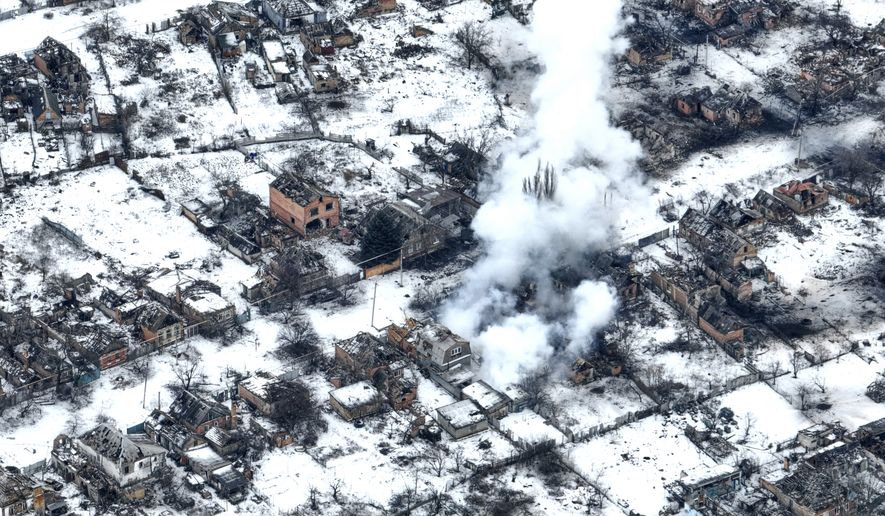Russia’s abysmal battlefield record in Ukraine is calling into serious question the effectiveness of post-Soviet military reforms that were supposed to transform Moscow’s army into a modern, well-equipped and competent force, according to an authoritative survey of the world’s major military powers released Wednesday.
The Military Balance audit of the world’s armed forces, issued annually by the London-based International Institute for Strategic Studies, estimated that Russia has lost 40% of its tank fleet in the fighting since it invaded neighboring Ukraine last February. Fierce fighting continues in contested areas of Ukraine’s east and south.
The war, launched by Russian President Vladimir Putin, has been a “military and political failure” for the Kremlin, the organization’s director, John Chipman, said in releasing the survey. Russia’s initial campaign in Ukraine was marked by overconfidence in its military ability and a crucial misjudgment of its opponent.
“The resistance of Ukraine’s armed forces and leaders and the resilience of its population proved key to thwarting Russia’s plans,” Mr. Chipman said.
The billions of dollars worth of military equipment and training provided to Ukrainian soldiers also has been key to Kyiv’s surprising successes, Mr. Chipman said.
“In its first real combat test against a determined conventional opponent, Moscow’s armed forces have so far come up short, particularly its ground forces,” he said.
Even U.S. government officials expected more from Russia’s military. In 2017, the Defense Intelligence Agency lauded Russia’s military modernization drive, known as the “New Look” program.
“The Russian military today is on the rise — not as the same Soviet force that faces the West in the Cold War, dependent on large units with heavy equipment, but as a smaller, more mobile, balanced force rapidly becoming capable of conducting the full range of modern warfare,” the DIA noted in its annual review of Russian military power.
“The new Russian military is a tool that can be used to underpin Moscow’s stated ambitions of being a leading force in a multi-polar world,” the DIA wrote.
The U.S. and its allies that are supporting and arming Ukraine had two major gatherings this week. One was a meeting Wednesday of Defense Secretary Lloyd Austin and other NATO defense ministers in Brussels.
“Things haven’t gone the way that the Kremlin planned. Putin expected Ukraine to surrender, and he expected the world to submit. History will record something very different,” Mr. Austin told reporters after the session. “Almost a year after Russia’s imperial invasion of Ukraine, NATO is more unified and more resolute than ever. We are determined to stand with Ukraine’s brave defenders for as long as it takes.”
The Russian Defense Ministry claimed to have made some rare advances Wednesday by breaking through two Ukrainian defensive lines in the eastern Luhansk region and pushing back Ukrainian troops some 2 miles, The Associated Press reported. It was not possible to independently verify Moscow’s claim. Despite the modest performance of Russian forces so far, Mr. Putin and his generals are mobilizing more forces to the front and conducting a sustained aerial campaign targeting Ukraine’s power grid and energy infrastructure.
Rising doubts
Russia’s actions over the past year have raised serious questions about the senior political and military leadership in the country and its command cohesion at the lower levels.
“The quality of Russia’s lower-level military leadership is low, highlighting the lack of an effective cadre of noncommissioned officers,” Mr. Chipman said. “There are reports of internal conflicts and the regular sacking of military leaders.”
The war in Ukraine is at a stalemate with little movement from either side at the front lines. Kyiv is planning a counteroffensive to eject Russian troops from its territory and wants to have at least 10 armored brigades in the field with modern NATO firepower, said Ben Barry, a retired British Army brigadier general and senior fellow at the International Institute for Strategic Studies.
“Meanwhile, [Russia] will continue to both fortify its defense and launch First World War-style attritional attacks in the Donbas,” Gen. Barry said. “Whichever side attacks first will get political and military ‘first mover’ advantages but also expose themselves to counterattacks.”
Both sides have sustained heavy casualties in the fighting. Agence France-Presse reported that about 180,000 Russian soldiers were killed or wounded, compared with about 100,000 Ukrainian troops. Moscow has been forced to call up conscripts and recruit convicts to fill the ranks, and reports indicate their newly mobilized and poorly trained troops have been decimated in combat.
The underwhelming performance of Russia’s forces could have major knockoff effects.
“Poor leadership, poor tactics, poor logistics, and underwhelming performance against a smaller and less-well-armed foe have left Russia’s military reputation in a shambles. That will have an impact,” said Steven Pifer, a senior fellow at the Brookings Institution. “Countries looking to buy weapons likely will begin to turn elsewhere given that Russia’s military failed to dominate early in the war, when its largely modernized forces faced a Ukrainian military armed mainly with aging Soviet-era equipment.”
The grinding war has highlighted the importance of weapons stocks and the defense production capacity needed to supply Ukraine with enough firepower to carry on the fight. Moscow also is looking to new sources for weapons — most notably Iran for armed unmanned aerial vehicles and direct attack munitions.
“In exchange, Iran may receive the Su-35 aircraft that Russia previously earmarked for Egypt, thereby beginning the modernization of Iran’s combat air fleet,” Mr. Chipman said.
The “Military Balance 2023” report also tracked continued growth and modernization by the Chinese People’s Liberation Army, which had a budget increase of $16 billion, or 7%, in 2022 — the largest ever in absolute terms.
“China’s military modernization continues apace,” the report said. “It is building its nuclear capabilities and adding new systems in space and on land, sea and in the air. China’s combat aircraft inventory has been transformed over the last five years.”
• This article is based in part on wire service reports.
• Mike Glenn can be reached at mglenn@washingtontimes.com.




Please read our comment policy before commenting.